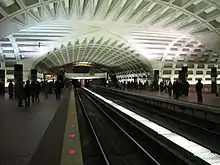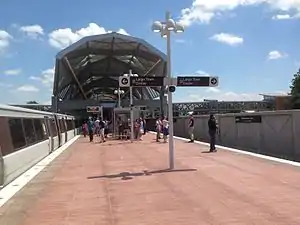The Washington Metro (commonly called Metro, and branded Metrorail) is a rapid transit system serving Washington, D.C. and neighboring communities in Maryland and Virginia, both inside and outside the Capital Beltway. With an average weekday ridership of 764,300, the Washington Metro is the second-busiest rapid transit system in the United States, behind the New York City Subway.[1] As of 2023, the system has 98 active stations on six lines with 129 miles (208 km) of tracks.
The Washington Metro system was conceived as an alternative to constructing a large freeway system throughout the Washington, D.C. area. It was partially financed with funds originally dedicated to highway construction.[2] Construction began in 1969, and in 1976 the first section of the Metro system opened along the Red Line between the Farragut North and Rhode Island Avenue stations in Washington, D.C. Throughout the 1970s and 1980s, more stations were opened in the city and the suburban communities of Arlington County, the City of Alexandria, and Fairfax County in Virginia as well as Montgomery and Prince George's Counties in Maryland. By 1991, five rail lines were open: the Red, Orange, Yellow, Green, and Blue Lines. The system, as originally planned, was completed in 2001 with the extension of the Green Line to Branch Avenue. In 2004, three stations were opened: an extension of the Blue Line to the Morgan Boulevard and Downtown Largo stations and the first infill station, NoMa–Gallaudet U.[3] The Silver Line opened in two phases, adding five stations in 2014 and six in 2022.[4][5] On the Yellow and Blue Lines, an additional infill station at Potomac Yard opened on May 19, 2023.[6]
Nine Metrorail stations are officially designated transfer stations, although other intermediate stations also allow passengers to transfer between lines. Four of these stations have separate, perpendicular upper and lower levels, which open at different times. Two other transfer stations, Rosslyn and Pentagon, have parallel stacked platforms. Ten stations are termini (stations at the end of lines); several other non-terminus stations are used to short turn trains in regular service.[7]
The busiest station in the system in 2023 was Metro Center, with more than 3.9 million passenger entries over the course of the year.[8] Rosslyn was the busiest station in Virginia, while Silver Spring was the busiest in Maryland. The system's 10 busiest stations are all located in Washington.
Lines
There are six Washington Metro lines, each named for a different color.[7] All lines except the Red Line share tracks.
| Line | Ridership (May 2010)[9] | Stations[7] | Termini[7] | |
|---|---|---|---|---|
| 277,741 (37%) | 27 | Shady Grove | Glenmont | |
| 187,663 (25%) | 26 | Vienna | New Carrollton | |
| 59,781 (8%) | 13 | Huntington | Mount Vernon Square | |
| 105,091 (14%) | 21 | Branch Avenue | Greenbelt | |
| 120,104 (16%) | 28 | Franconia–Springfield | Downtown Largo | |
| — | 34 | Ashburn | Downtown Largo | |
Stations



.jpg.webp)
.jpg.webp)





| * | Official transfer stations |
| † | Terminals |
| *† | Transfer station and terminal |
Notes
- a Stations noted in this list twice with upper and lower levels are considered by WMATA as a single station. The levels are noted separately here because they opened on different dates.
References
- ↑ "Transit Ridership Report: First Quarter 2015" (PDF). American Public Transportation Association. May 27, 2015. Archived from the original (PDF) on September 23, 2015. Retrieved August 26, 2015.
- ↑ Schrag, Zachary (2006). The Great Society Subway: A History of the Washington Metro. Johns Hopkins University Press. ISBN 0-8018-8246-X.
- ↑ "WMATA History" (PDF). Washington Metropolitan area Transit Authority. 2007. Archived from the original (PDF) on October 15, 2012. Retrieved August 26, 2015.
- ↑ George, Justin (June 9, 2022). "Metro's Silver Line extension moves closer to finish line". The Washington Post.
- 1 2 3 "Metro Facts" (PDF). Washington Metropolitan area Transit Authority. 2014. Archived from the original (PDF) on February 22, 2016. Retrieved August 26, 2015.
- ↑ Laris, Michael (May 19, 2023). "Potomac Yard Metro station, decades in the making, opens in Alexandria". Washington Post. Retrieved May 19, 2023.
- 1 2 3 4 5 6 "Stations". Washington Metropolitan Area Transit Authority. Retrieved December 28, 2017.
- ↑ "Metrorail Ridership Summary". Washington Metropolitan Area Transit Authority. Retrieved January 10, 2024.
- 1 2 3 4 "Metro Media Guide" (PDF). Washington Metropolitan Area Transit Authority. 2010. Archived from the original (PDF) on July 28, 2012. Retrieved July 14, 2011.
- ↑ "Rail Ridership Data Viewer | WMATA". www.wmata.com. Retrieved January 8, 2024.